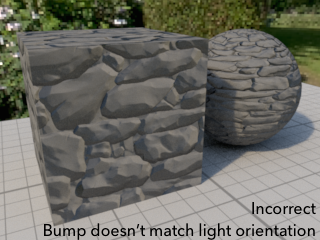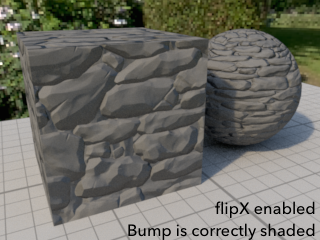Contents
Produces a bumped normal from a normal map (a color map encoding the normal). Bumps are applied in object space. The change in scale between object space and current space is automatically applied by the node.
Like the other texture nodes, this node takes a manifold which describes either a 2D or 3D domain to apply a the texture to. The default behavior if no manifold is attached, is to apply over the s,t domain defined on the geometry.
Texture atlas format files can be read in either UDIM (Mari) format or mudbox format.
Input Parameters
Bump Scale
Scale the bump effect. Typical range is from 0.0 to 2.0.
Input Normal
Specifies normal map color (this parameter is ignored if Filename is provided).
Filename
Normal map filename. The shader reads only one channel of the file from the Mapping Controls' Channel specified below. Note that this will be read in as the Mudbox normal map format in tangent space.
Bump Overlay
Connect a PxrBump or PxrNormalMap node here if you need to combine multiple patterns.
Bump Orientation
Invert Bump
Invert the bump orientation. Concave becomes convex and vice versa.
Orientation
Some texturing applications offer different orientations, like OpenGL or DirectX. You can also go manual (choose "Custom") to try to fix your normal map's appearance.
Flip X
Flips the x axis (red channel) of the normal map. There isn't any standard to encode normal maps and every application will encode them differently. This switch, combined with Flip Y and Invert Bump will allow you to set the correct orientation.
This switch is only visible when Orientation is set to "Custom".
Flip Y
Flips the y axis (green channel) of the normal map. There isn't any standard to encode normal maps and every application will encode them differently. This switch, combined with Flip X and Invert Bump will allow you to set the correct orientation.
This switch is only visible when Orientation is set to "Custom".
Mapping Controls
Channel
Offsets the first channel to be looked up for filename.
Atlas Style
Specifies the style of texture atlas that is being used. If you specify an atlas style, the Filename parameter must contain a _MAPID_, which will be substituted automatically according to the surface parameterization and the style of atlas. Valid styles are:
- 0: None
- 1: MARI
- 2: Mudbox
Invert T
Inverts the t texture coordinate for texture lookup.
Blur
Specifies how much to blur the result from the texture file.
Mip Interpolate
Selects whether to interpolate between adjacent resolutions in the multi-resolution texture, resulting in smoother transitions between levels.
Filter
Selects different reconstruction filters that can be used during texture lookup. The filters available for PxrNormalMap are:
- 1: Box
- 4: Mitchell
- 5: Catmullrom
- 6: Gaussian
- 7: Lagrangian
Manifold
Provides the range over which to apply the texture. Defaults to s,t.
Advanced
Reverse Normal
Reverse the resulting normal.
Disabled
Use the geometric normal (ignore the modified normal).
MipBias
Bias mip selection chosen for rendering to either a higher (negative integers) or lower resolution (positive integers) selection.
MaxResolution
Clamp mip selection to a preferred maximum level. This may prevent the highest resolutions from being rendered depending on your selection.
OptimizeIndirect
Sets texture filter to Box (inexpensive) on indirect hits instead of the selected filter used for other visible effects.
Output Parameters
resultN
The bumped normal.
Normal Maps Orientation
Sometimes you might apply a normal map to your geometry and it will look wrong. Generally, it's an orientation problem and you will have to find the correct combination of Invert Bump, Flip X, and Flip Y. The best method is to start an IPR/LiveRender session and try various combinations. Once you have found the correct combination for your authoring application (ZBrush, Mudbox, 3DCoat, etc), it should be good for all maps exported from that application with the same settings.


